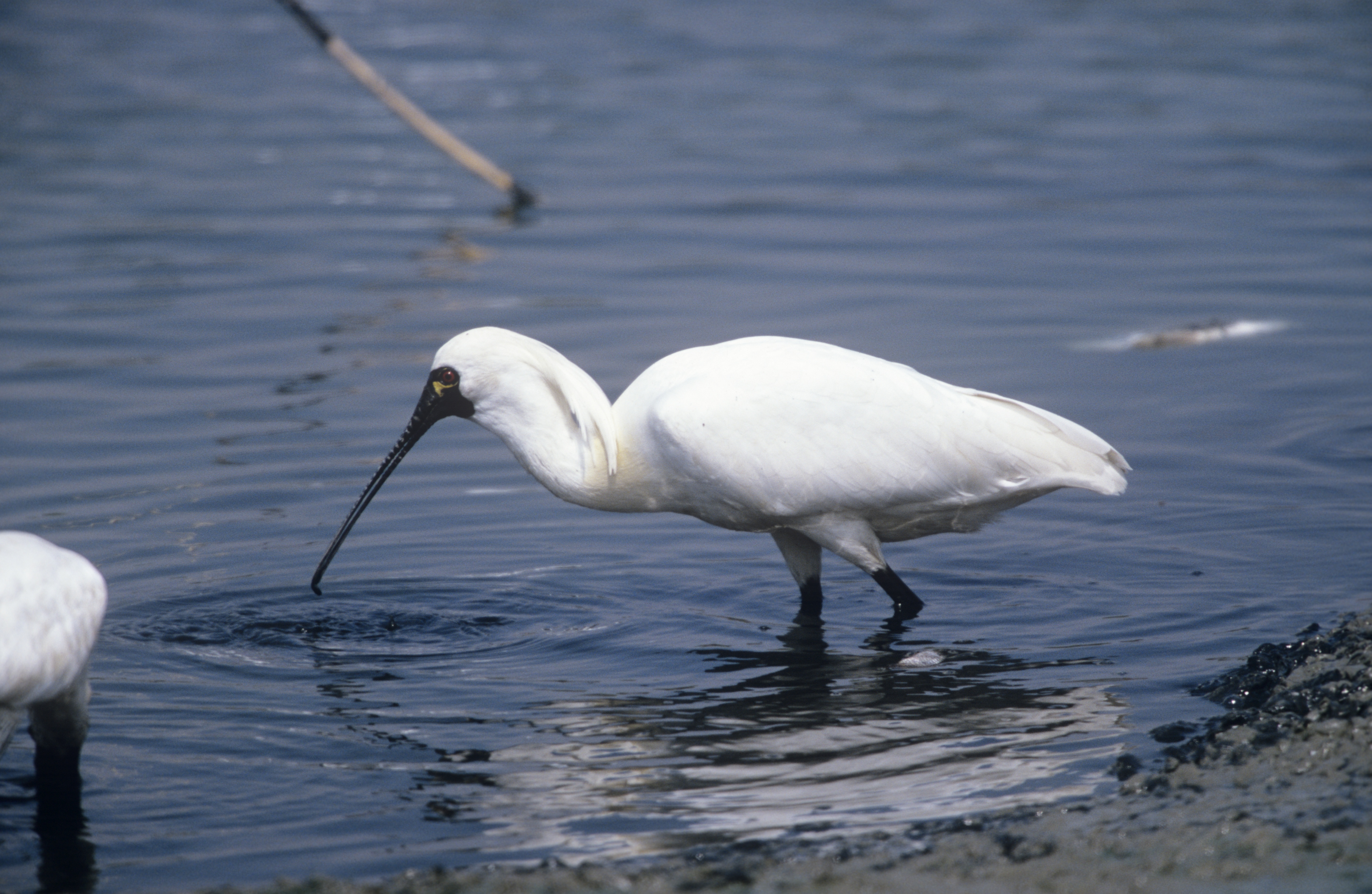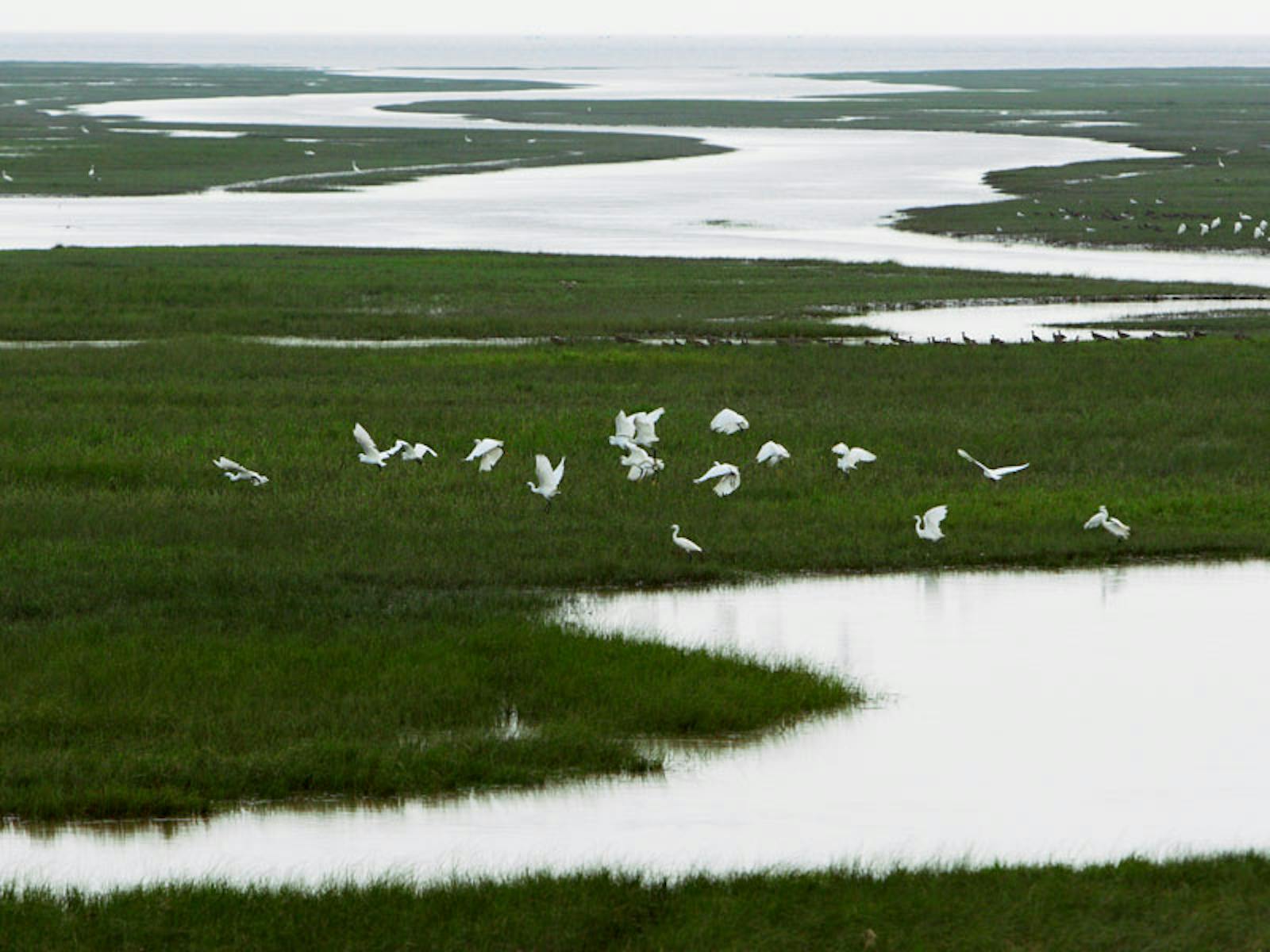Yellow Sea Saline Meadow
The ecoregion’s land area is provided in units of 1,000 hectares. The conservation target is the Global Safety Net (GSN1) area for the given ecoregion. The protection level indicates the percentage of the GSN goal that is currently protected on a scale of 0-10. N/A means data is not available at this time.
Bioregion: Chang Jiang Plain Evergreen Forests (PA50)
Realm: Eastern Eurasia
Ecoregion Size (1000 ha):
533
Ecoregion ID:
748
Conservation Target:
45%
Protection Level:
10
States: China
Along the eastern coast of China, at subtropical to warm temperate latitudes, rivers like the Changjiang (Yangtze) and Huai He (Yellow) deposit billions of tons of sediment per year into calm coastal waters, growing the land seaward at almost one square kilometer a year. As these new surfaces accrete upwards through the intertidal zone, they come to support meadows of salt tolerant grasses and sedges.
One reach of coastal saline meadow, the Yancheng coastline, extends northward from the mouth of the Yangtze River towards the Shandong Peninsula, holding the Yellow Sea Saline Meadow ecoregion. Onshore, this habitat supports salt tolerant reed grasses, sedges, and succulents. Seaward, invertebrate-rich mudflats up to five kilometers wide provide a secure ‘refueling’ place for migratory waterfowl and shorebirds on the Siberian-Australasian flyway.

The flagship species of the Yellow Sea Saline Meadow ecoregion is the black-faced spoonbill. Image credit: Creative Commons
The region between the Huai He and Changjiang Rivers is also the dividing point between the temperate and subtropical climatic zones. The region experiences humid to semi-humid monsoon climates, with an average annual precipitation between 800–1,200 mm. Typhoons often hit this region at the end of summer and in early fall. The average temperature is 2o–4°C in January and 26o–29°C in July.
This ecoregion is protected under UNESCO’s World Network of Biosphere Reserves as the Yancheng Coastal Wetlands and is listed in the Ramsar Convention’s Wetlands of International Importance. The Yancheng coastline, which extends several hundred kilometers northward from the mouth of the Yangtze River, receives nearly two million birds during the spring and autumn migration, and more than 200,000 avian visitors during winter.
Saline meadows along this coastal margin are dominated by Suaeda salsa, a salt-tolerant succulent seepweed. Grasslands further inland (now behind a sea wall) are dominated by Imperata cylindrica, a tall, perennial grass that is widespread in Asia. Freshwater marshes of Phragmites reed grass, Scirpus sedge, and other graminoids were once prevalent in this ecoregion, but today the freshwater marshes are almost completely replaced by rice agriculture and fish aquaculture.
Yancheng Biosphere Reserve (3,690 km2), the main protected area for the Yellow Sea saline meadow ecoregion, consists of a core area (234 km2) with much larger transition and buffer zones. It provides critical breeding habitat for about 40% of the remaining world population of endangered red-crowned crane. Overwintering birds include Dalmatian pelican, endangered black-faced spoonbill, and relict gull. Intertidal mudflats of this ecoregion support the world’s largest breeding colony of Saunders’s gull.
The black-face spoonbill has the most restricted range of the six spoonbill species. During the past three decades, its population has recovered from an estimated 300 individuals to more than 2,000 thanks to international conservation effort. It breeds on the Korean Peninsula and coastal parts of Manchuria and winters in southern China, and the coastal intertidal zone of this ecoregion provides important migratory stopover habitat. Altogether, 381 bird species are recorded in Yancheng Biosphere Reserve.

Chinese water deer. Image credit: Nick Goodrum, Creative Commons
The critically endangered Chinese paddlefish once moved between breeding pools far up the Yangtze River and the brackish coastal waters of this ecoregion, but its migratory cycle was halted by dam construction in the early 1980s. Now the Chinese paddlefish—one of the largest freshwater fish—may be extinct, as it has not been recorded for at least 10 years.
Dafeng Milu Nature Reserve (core area 27 km2) includes remnants of coastal grassland habitat that support one of China’s re-introduced populations of Perè David’s Deer, extinct in the wild. A small herd of captive animals, delivered from the United Kingdom in 1986, had increased to 950 head in 2006. Chinese water deer also occur in this ecoregion, preferring habitats with tall, concealing reed grasses. The canine teeth of this small cervid erupt as tusks like those of a musk deer, but genetically it is closer to European roe deer.
The warm-temperate margin of the Yellow Sea—renowned as a ‘land of fish and rice’—supports a high human population density. Since coastal habitat has been a primary resource base for so many people for so many years, it is not surprising that little today remains wild. Commercial aquaculture—fish, shrimp, and clams—is well established, and this area was China’s main center for salt production for more than 2000 years. While the coastal strand includes some intact habitat, places further inland have lost practically all of their natural vegetation.
Since the sediments of the Yangtze-Huai river delta system are growing new land seaward at more than 10 m a year, sustainable development is an option on new land undergoing primary ecological succession. One hopes that, as coastal habitat is settled and tamed, some might be protected to sustain coastal biodiversity.
The priority conservation actions for the next decade are to: 1) strengthen regulations to protect less disturbed, critical wildlife habitat from encroachment; 2) anticipate and explore ways to mitigate ecological effects of sea-level increase; and 3) seek opportunities to protect new wetland habitat as it emerges from the sea.
Citations
- Carpenter, C. 2000. Eastern Asia: Eastern coast of China. https://www.worldwildlife.org/ecoregions/pa0908. Accessed December 2018.
- Qiwei, W. 2010. Psephurus gladius. The IUCN Red List of Threatened Species 2010. http://dx.doi.org/10.2305/IUCN.UK.2010-1.RLTS.T18428A8264989.en. Accessed December 2018.
- UNESCO MAB Programme. Yancheng. http://www.unesco.org/new/en/natural-sciences/environment/ecological-sciences/biosphere-reserves/asia-and-the-pacific/china/yancheng/. Accessed December 2018.



